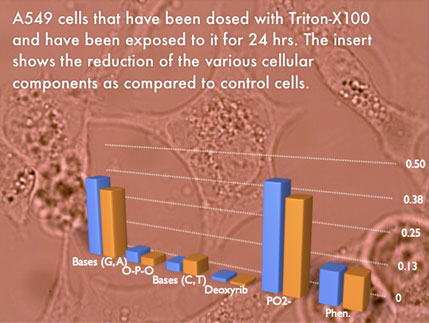PIs: K. W. Powers and B. M. Moudgil
PERC Team Members: K. W. Powers, B. M. Moudgil, G. Pyrgiotakis, P. Sharma, S. C. Brown, K. Finton
 The nanoparticle cell interactions have been recently emerged as a key component in evaluating the biological impact of nanotechnology and possible environmental implications. Currently there are several biological assays for in vitro evaluation of nanoparticles toxicity that solely rely on the detection of certain molecules that are released or absorbed by the cell through the cellular death process. This imposes certain limitations in the case of the nanoparticle cell interaction since more complicated phenomena such is the adsorption on the particles surface. There are modifications that can increase the reliability of the assays and make the evaluation of particle toxicity through the conventional biological assays. A major limitation, however, is the required time that is in the range of a few hours and therefore the monitoring of relatively interactions that happen in the same timescale as the time required by the assay, cannot be monitored.
The nanoparticle cell interactions have been recently emerged as a key component in evaluating the biological impact of nanotechnology and possible environmental implications. Currently there are several biological assays for in vitro evaluation of nanoparticles toxicity that solely rely on the detection of certain molecules that are released or absorbed by the cell through the cellular death process. This imposes certain limitations in the case of the nanoparticle cell interaction since more complicated phenomena such is the adsorption on the particles surface. There are modifications that can increase the reliability of the assays and make the evaluation of particle toxicity through the conventional biological assays. A major limitation, however, is the required time that is in the range of a few hours and therefore the monitoring of relatively interactions that happen in the same timescale as the time required by the assay, cannot be monitored.
On a different front, the recent years the Raman spectroscopy has been prove a great tool for in-situ and in vitro studies of cells responses on different agents and evaluation of the toxicity thereof. Although the Raman investigation of cell has been reported a few decades earlier, only recently this technique gained attention after the employment of the IR laser (785 nm), which does not damage the cells. in investigating the particle cell interactions and evaluation of the toxicity. The major advantages of Raman Spectroscopy include the non invasive nature, independence of particle and cell type and the relatively rapid data acquisition.
The ultimate goal is to develop a rapid, accurate, reliable and inexpensive screening device for potential adverse effects nanotochnology based products can have on humans. The coupling of the project with informatics and datamining techniques, gives flexibility and applications that expand beyond the boundaries of the original vision, such cell identification and cancer detection.
- Pyrgiotakis, G., T.K. Bhowmick, K. Finton, et al., Cell (A549)-particle (Jasada Bhasma) interactions using Raman spectroscopy. Biopolymers, 89(6): p. 555-564 (2008).
- Bhowmick T.K., Pyrgiotakis, G., K. Finton, et al., A Study of the effect of Jasada Bhasma particles on Saccharomyces cerevisiae (yeast) cells by Raman Spectroscopy, Journal of Raman Spectriscopy, Accepted (2008).